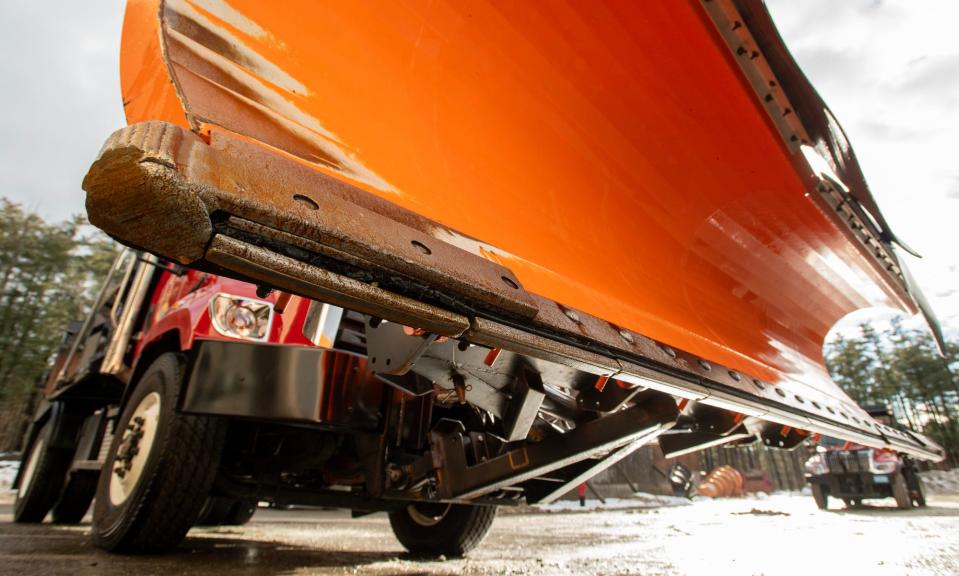STERLING – It’s not your grandpa’s snow-and-ice-removal world anymore. Times have changed. Look no further than Sterling for proof.
Work crews in the Central Massachusetts town of 8,000 use high-tech flexible plow blades to get snow and ice off the streets. The blades fit the contours of the road that allow more snow and slush to be scraped off. Less muck left behind means less salt is needed to treat the roads.
Sterling’s DPW Superintendent Ryan Mouradian explained that process, adding the town also has so-called closed loop spreader controllers on order. When they arrive, trucks equipped with sensors can track how much salt is put on the roads.
Yes, we all know that salt melts snow. But today, it’s all about using less salt to help the environment and save towns money. In Sterling, the new equipment helped go from 5,000 tons of salt used in the winter of 2020-2021 to 2,400 tons last winter. That’s a 52% reduction.
“We strive to use the right amount of salt and have safer roads while reducing environmental impacts, as much as we can,” said Mouradian. “Plus, in the long run, it saves money. Less salt used is less spent on it.”
Salt levels rising in Wachusett Reservoir
Sterling is a microcosm of what’s happening in towns in the Wachusett Reservoir watershed, as they strive to lower salt use at a time when the amount of salt in the reservoir is rising. The spike occurred over the past 10 years, said Kelley Freda, the Massachusetts Department of Conservation and Recreation’s regional director for the Wachusett and Sudbury watersheds.
Higher salt (sodium chloride) levels not only impact the reservoir’s aquatic life but also how the water is treated for use as drinking water. Besides the Quabbin Reservoir and Ware River, the 65-billion-gallon Wachusett Reservoir supplies drinking water to 3.1 million residents in Eastern Massachusetts through the Massachusetts Water Resources Authority.
One reason the reservoir’s salt level has spiked in the past decade, said Freda, is residents and municipalities don’t understand how much salt they need to keep the roads from getting too slick: “They don’t need as much as they’re putting down.”
Outdated highway equipment also contributes to too much salt being applied, according to Freda. Communities that use rock salt have the salt bouncing off the roads and it ends up in unintended places.
Some of the salt is entering groundwater and lakes and streams through runoff that feeds into the Wachusett Reservoir. The water body’s aquatic life suffers, from tiny microorganisms to large fish, and Freda said aquatic life is the backbone for water quality.
Data highlights problem
Monitoring wells in the reservoir’s watershed indicate salt levels higher than they’ve ever been, said Freda. Meanwhile, monthly water samples collected by the Massachusetts Water Resources Authority show a noticeable increase in salt content.
The annual mean chloride concentration in the reservoir in 2022 was 27.03 milligrams per liter, compared to 18.46 milligrams per liter in 2012. Both numbers are well below the levels established by the U.S. Environmental Protection Agency for chlorides considered toxic to aquatic life. The chronically toxic level is 230 milligrams per liter and acutely toxic is 860 milligrams per liter.
What role does Worcester play?
A small tip of northern Worcester sits in the Wachusett Reservoir’s watershed, and it appears salt impacts to the reservoir from the city’s runoff are minimal.
Jay Fink, the city’s commissioner of Public Works & Parks, explained that many of Worcester’s reservoirs are in north Worcester and Holden, and much of the city’s runoff flows into Mill Brook on its way to Narragansett Bay.
In a typical year, Worcester uses 10 to 15 tons of salt to treat the roads, said Fink. City crews and contract plows hit the roads during storms, and equipment is not calibrated to limit the amount of salt.
The goal to is to lay down salt as quickly and far-reaching as possible to keep city roads safe, said Fink. Besides, getting a new plow or truck doesn’t happen overnight. It typically takes more than an year after ordering one before it arrives.
“The primary driver for Worcester winter operations, and cutting down on salt, is more from an economic standpoint than an ecological one,” said Fink.
What can be done about elevated salt levels?
Freda noted Wachusett Reservoir’s water remains at a high quality, and that Massachusetts has one of the cleanest water systems in the country. But what can be done about rising salt levels in the reservoir?
One answer is brine, but not the kind used to prepare a moist turkey for the Thanksgiving dinner table. This brine is a salt-and-water mixture applied to roads before a storm. It keeps salt from bouncing off the pavement. Snow also doesn’t stick as much, so crews don’t have to reapply more salt.
One drawback is this brine is expensive, in terms of making or buying it and having the equipment to spread it on roads. Sterling doesn’t use it for those reasons, but Mouradian called it “proven technology” that his town will likely use in the future.
It may be expansive, but it achieves results. Freda noted brine resulted in a 30% cut yearly in the amount of salt used on lands in the Wachusett Reservoir watershed that are owned by the state Department of Conservation and Recreation.
Besides brine, other methods to lower salt use include state grants available for the seven municipalities in the watershed: Sterling, Boylston, West Boylston, Holden, Princeton and small sections of Worcester and Leominster.

A $10,000 grant helped pay for Sterling’s flexible plow blades and $20,000 more will help defray the costs of closed loop spreader controllers. There’s also free education and training to watershed towns to cut salt use and impacts on the reservoir. Mouradian noted his entire highway team took the classes.
Everyone has a role to play
Education isn’t limited to municipal crews. Each of us has a role to play, said Freda, and the state has developed ways to educate the public on how to use less salt. One is a video tutorial that explains how to make brine to apply to your driveway and sidewalk before a snowstorm.
There’s also a push to educate high school students about using less salt, so they can grow up to do their part for the environment and protect water quality.
Ultimately, communities are “very receptive” to reducing salt that flows into Wachusett Reservoir, said Freda. However, there are no regulations to force them to do it.
“We’re trying to encourage communities to make changes,” she said.
Contact Henry Schwan at henry.schwan@telegram.com. Follow him on X: @henrytelegram.
This article originally appeared on Telegram & Gazette: High salt levels pose threat to Wachusett Reservoir watershed
Signup bonus from





